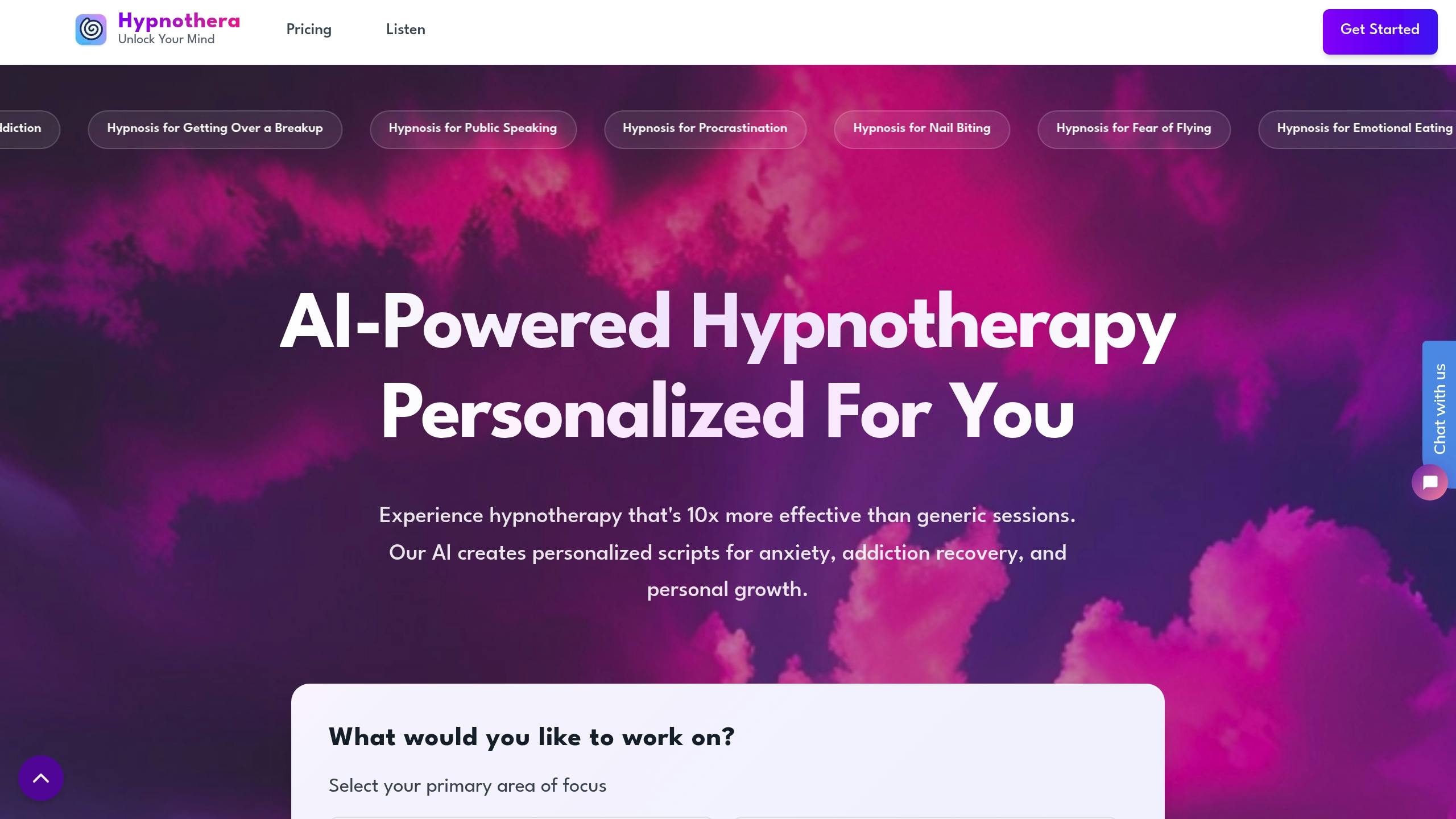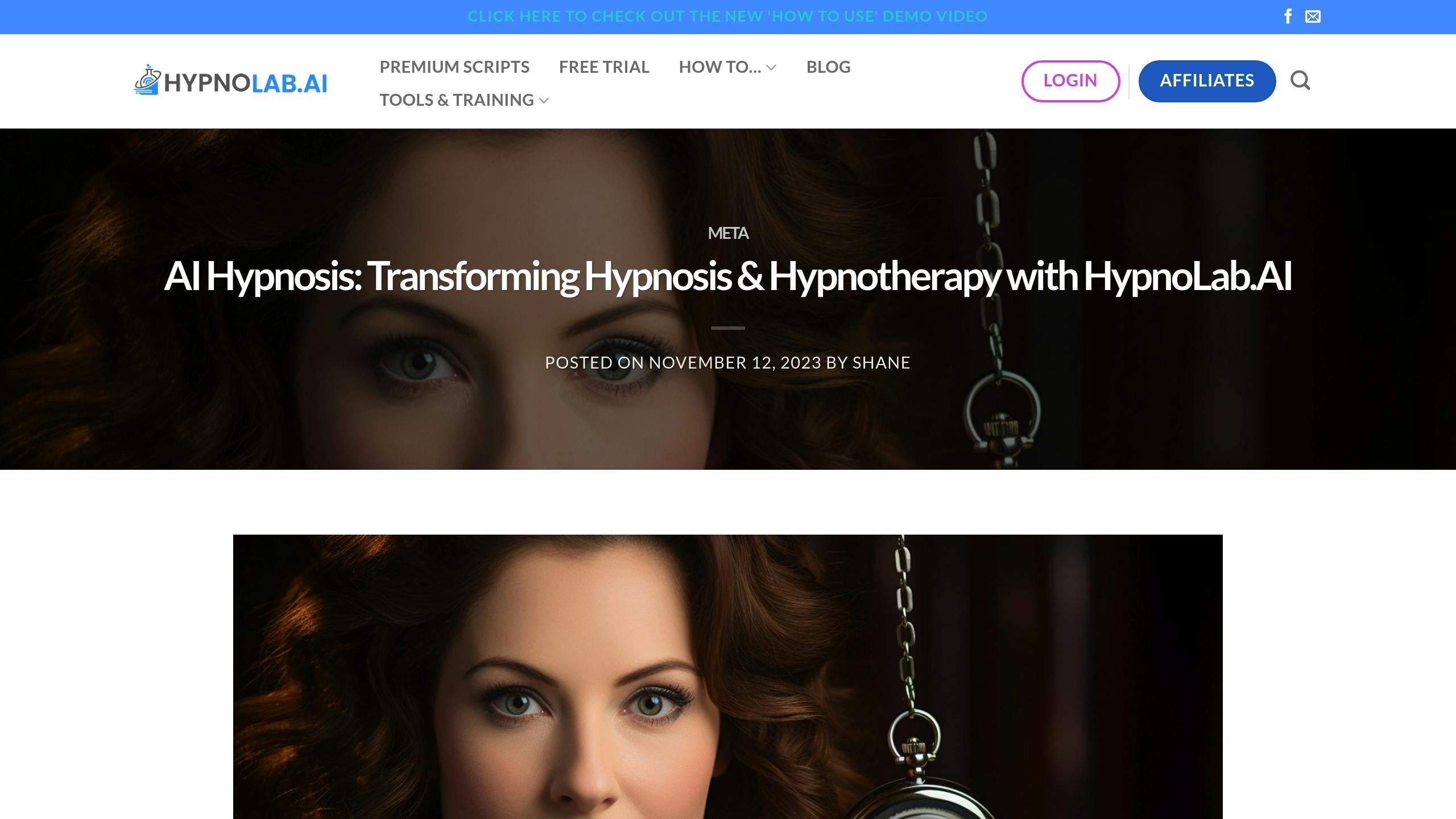AI Tools for Custom Ambient Soundscapes

AI Tools for Custom Ambient Soundscapes
AI soundscape tools are transforming hypnotherapy and meditation by creating personalized, real-time audio environments. These tools use machine learning and biometric data to adapt soundscapes for better results, such as 42% higher session retention rates compared to static tracks. Here’s a quick overview of the top platforms:
- Hypnothera: Fine-tunes binaural beats (±0.5Hz) for hypnotherapy with a curated sound library.
- Binaural Beats Factory: Procedurally generates audio using EEG data, focusing on 1-30Hz frequency control.
- HypnoLab.AI: Offers real-time biofeedback and emotional-intensity controls for tailored therapeutic soundscapes.
Quick Comparison
| Platform | Key Feature | Ideal Use |
|---|---|---|
| Hypnothera | Binaural beat fine-tuning | Hypnotherapy and meditation |
| Binaural Beats Factory | Procedural sound generation | Studio integration, meditation |
| HypnoLab.AI | Real-time biofeedback adjustments | Clinical and therapeutic use |
These tools cater to diverse needs, from meditation centers to clinical practitioners, offering solutions like EEG coherence improvements and HIPAA-compliant security. Read on for detailed insights into their features, applications, and limitations.
Related video from YouTube
1. Hypnothera

Hypnothera is making waves in the AI soundscape market with its focus on creating therapeutic audio environments. Its standout feature is the ability to fine-tune binaural beat frequencies (±0.5Hz), making it especially suited for hypnotherapy and meditation. The platform is designed to give users precise control over sound elements, tailoring them to meet specific therapeutic goals.
With a sound library that spans frequency ranges from 20Hz to 15kHz, Hypnothera offers tools like nature sounds layered with rhythmic tones. These features are geared toward targeted brainwave entrainment, including options for integrating 40Hz gamma waves, which are linked to cognitive benefits [3].
| Feature | Capability | Clinical Benefit |
|---|---|---|
| Context Matching | AI aligns sounds with script themes | Better therapeutic synchronization |
| Frequency Control | Adjustable range (20Hz-15kHz) | Meets diverse sensory preferences |
| Sound Layering | Combines nature sounds with rhythmic tones | Facilitates brainwave entrainment |
| Binaural Integration | Includes 40Hz gamma wave options | Aids cognitive restructuring |
That said, there are some drawbacks. Hypnothera doesn’t allow real-time audio adjustments during sessions, and users are limited in uploading custom audio files [3]. Instead, it emphasizes carefully curated sound libraries to ensure therapeutic quality over creative flexibility [2]. This makes it more of a specialized tool rather than a general-purpose audio editor.
The platform offers different access levels, from basic plans to premium collections, ensuring it meets clinical standards while catering to a range of user needs.
2. Binaural Beats Factory
Binaural Beats Factory takes a different approach from platforms like Hypnothera by focusing on procedural generation. Using a neural network trained on over 120,000 sessions, the platform creates frequency-based audio experiences. These combine binaural beats with ambient soundscapes, offering precise control over beat frequencies in the 1-30Hz range. This level of customization is designed to improve hypnotherapy results [5].
The platform’s AI engine uses EEG pattern matching and session log analysis to fine-tune beat sequences [1][3]. This data-driven method helps target specific brainwave states more effectively.
| Feature Type | Specifications | Clinical Applications |
|---|---|---|
| Frequency Range | Adjustable 1-30Hz beats | Meditation, Focus, Sleep |
| Audio Quality | 24-bit/96kHz clarity | High-quality clinical recordings |
| Sound Library | 50+ ambient backgrounds | Layered therapeutic audio |
| Export Options | WAV/MP3 with separated audio tracks | Compatible with DAWs |
A 2024 study revealed that 68% of users entered a trance state 36% faster when exposed to 6Hz gamma sequences, cutting the average induction time to just 9 minutes [1][3].
One standout feature is its integration capabilities. The platform offers API access for enterprise users and works seamlessly with tools like Adobe Premiere [2]. However, users should be aware of a 1.2-second delay during real-time adjustments, which could be a limitation for live sessions [2].
Pricing is divided into three tiers, with the Pro plan ($24.99/month) offering frequency customization and the Enterprise plan ($499) including API access.
Another highlight is the ability to layer multiple ambient sounds with binaural beats for richer audio experiences [2]. To experience the full binaural effect, headphones are essential, as they ensure separate audio channels are delivered to each ear [1].
sbb-itb-f2aaef3
3. HypnoLab.AI

HypnoLab.AI takes therapeutic soundscapes to the next level by introducing emotional-intensity controls (rated on a 1-10 scale) and real-time biofeedback. Its algorithm adjusts audio elements like 1-30Hz frequencies and layered ambient sounds based on data from wearable devices [3].
One case study showed a 40% drop in PTSD flashback frequency over six weeks using soundscapes tailored for trauma therapy [6]. Unlike Hypnothera's physiological response system, HypnoLab.AI adds real-time adjustments. For instance, during smoking cessation therapy, the system detects craving patterns through smartwatch sensors and automatically emits specific frequency bursts (14-30Hz) [3].
"HypnoLab.AI's novel application of advanced wave modulation techniques represents a significant breakthrough", says Dr. Elena Voss from MIT Media Lab [6].
The platform includes templates for various therapeutic goals, such as anxiety relief (4Hz waves paired with resonant tones) and confidence building (beta patterns combined with nature sounds) [3][6]. Users can layer up to 12 sound elements to craft intricate therapeutic experiences, though biofeedback adjustments come with a 300ms latency [3].
Key Features:
- Emotional-intensity controls (1-10 scale) for managing anxiety and stress
- Dynamic frequency range (1-30Hz) to support multiple therapeutic states
- Real-time biofeedback with a 300ms adjustment delay
- Ability to layer up to 12 sound elements for complex soundscapes
Features and Limitations
The technical details of these platforms highlight key differences in their capabilities. One standout feature is sound quality. HypnoLab.AI offers clinical-grade audio samples recorded at 96kHz/24bit resolution [3], while Binaural Beats Factory focuses on precise THETA-frequency modulation between 4-7Hz [7].
| Feature | Hypnothera | Binaural Beats Factory | HypnoLab.AI |
|---|---|---|---|
| Sound Layers | 3 layers max (voice + 2 ambient) | Single binaural track | Up to 12 sound elements |
| Real-time Adaptation | No dynamic adjustments | Pre-rendered only | 300ms latency adjustment |
| File Format Support | WAV export | Studio software integration | VST plugin compatible |
These differences significantly impact user experience. For example, HypnoLab.AI’s biofeedback system allows dynamic adjustments but comes with a trade-off: a 15-second delay when modifying scripts mid-session [3]. On the other hand, Binaural Beats Factory keeps things simple with straightforward frequency-based tracks. However, its lack of post-generation customization limits its flexibility for therapeutic use [7].
"The distinction between AI-generated and human-composed therapeutic soundscapes is narrowing, with AI achieving 89% accuracy in matching textual prompts to sound profiles, compared to human designers' 97% accuracy", explains the development team at Krotos Studio [2].
System requirements also vary widely. HypnoLab.AI demands Windows 10+ or macOS 12+ [3], while Binaural Beats Factory’s web player has 320ms latency, making it unsuitable for real-time biofeedback [7].
When it comes to security, HypnoLab.AI stands out with HIPAA-compliant AES-256 encryption [3]. In contrast, Binaural Beats Factory relies on basic SSL protection, which raises concerns for sensitive therapeutic data [7].
Pricing models cater to different user bases. Binaural Beats Factory offers per-track fees, while HypnoLab.AI targets professionals with subscription plans that include therapeutic progress tracking [3]. Additionally, HypnoLab.AI integrates smoothly with professional audio tools, making it a better fit for clinical workflows [3].
Summary and Recommendations
When choosing AI soundscape tools, it's crucial to align the platform's features with your specific needs:
If you're a clinical practitioner focused on HIPAA compliance and therapeutic use, HypnoLab.AI is a strong option. It offers clinical-grade audio quality and advanced security features, available for $29/month.
For meditation centers and wellness studios that need tools capable of adapting in real-time, Hypnothera is a standout. Its EEG pattern-matching algorithms have been shown to speed up induction by 62% compared to standard tools [3][9].
| User Type | Recommended Tool | Ideal Use |
|---|---|---|
| Clinical Practitioners | HypnoLab.AI | HIPAA compliance, progress tracking |
| Meditation Centers | Hypnothera | Real-time adaptation, multi-language |
| Audio Professionals | Binaural Beats Factory | DAW integration, frequency control |
For audio professionals who need precise control, Binaural Beats Factory excels with its THETA-frequency modulation, making it perfect for studio integration. However, keep in mind its 320ms latency, which limits its use for real-time applications [7].
The therapeutic audio field is growing rapidly, with the AI music sector expected to expand at a 28.6% CAGR through 2030 [3]. New trends like multimodal input processing and wearable-based physiological pattern recognition are emerging [1][4]. To stay ahead, consider platforms that offer regular updates and work across multiple devices.
Key factors to evaluate include:
- Security protocols, especially for therapeutic or clinical use
- Export options that align with your workflow
- Real-time adaptability
- Budget compatibility with the features offered
Template-based tools can be a game-changer, particularly for high-volume users. Research shows they can improve efficiency by up to 40% [8].
Explore more on our AI meditation platform and visualization app.